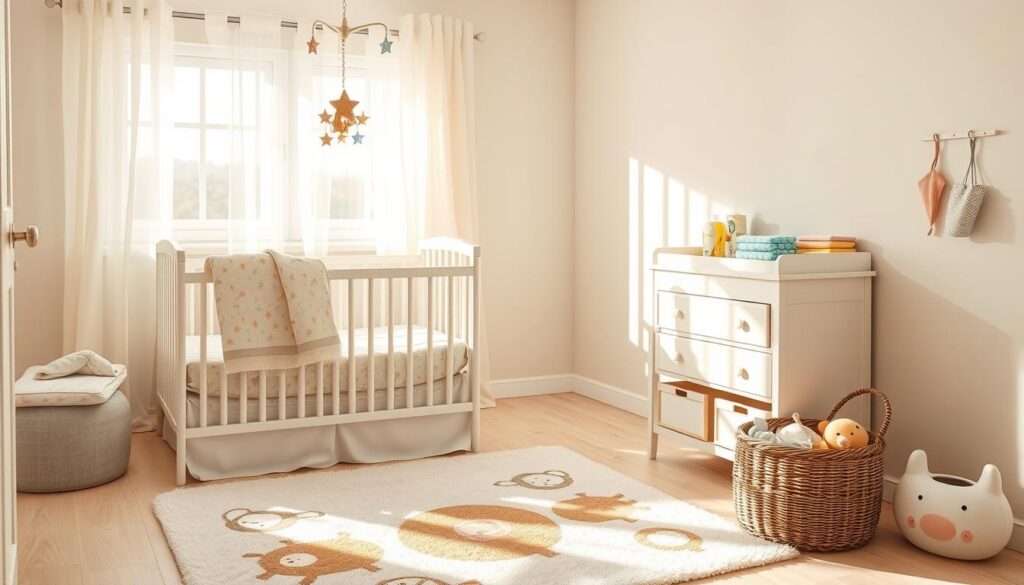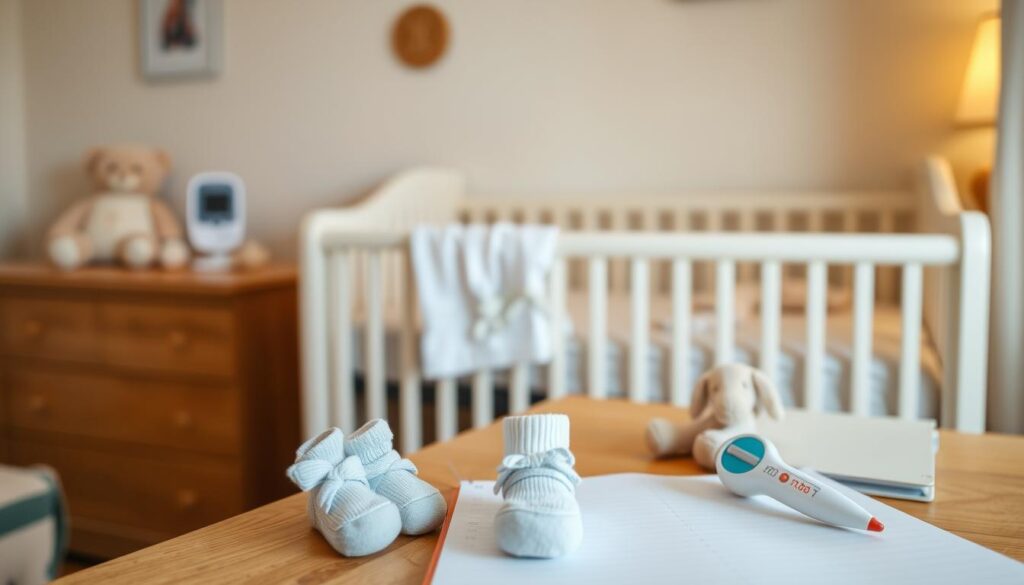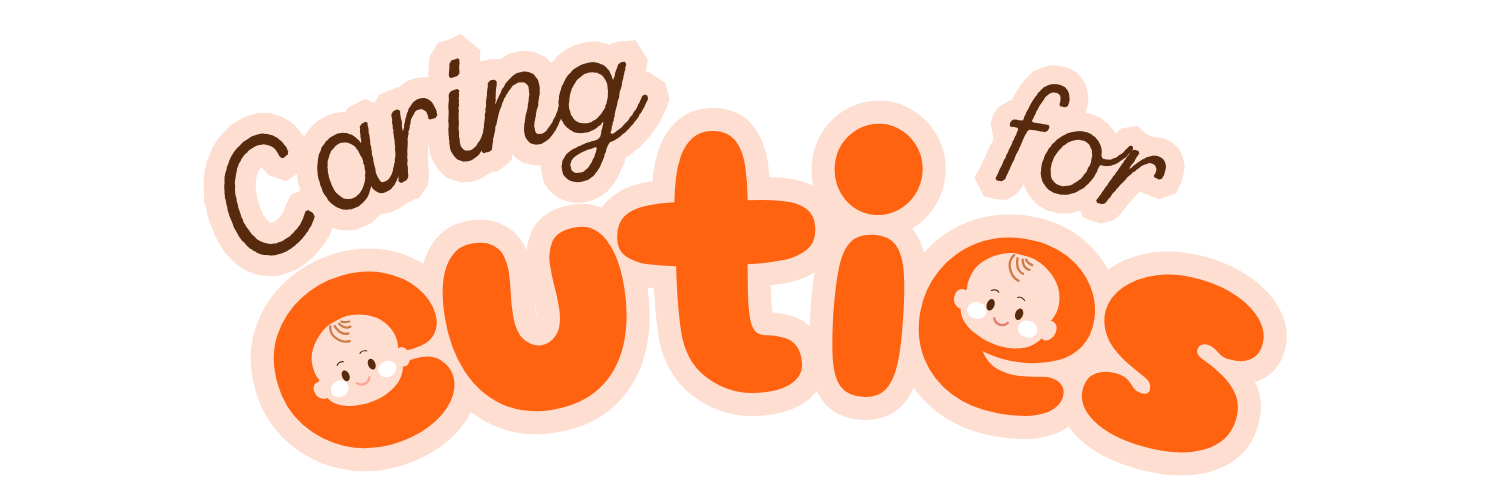Are you ready to learn how to care for your newborn and build a strong bond? Welcoming a newborn is both thrilling and scary for first-time parents. It’s important to know your baby’s needs and create a safe space. This guide will help you understand and care for your newborn with confidence, covering the essential newborn care tips every parent needs to know.

Key Takeaways
- Understand your newborn’s basic needs and how to meet them effectively
- Create a safe home environment to support your baby’s growth and development
- Establish a reliable support system to help you during this transformative time
- Learn the fundamentals of newborn feeding, including breastfeeding and bottle-feeding
- Develop healthy sleep habits and a comfortable sleep environment for your little one
Essential Newborn Care Basics for First-Time Parents
Welcoming a newborn can be thrilling yet overwhelming, even for first-time parents. It’s key to know your baby’s basic needs and make a safe, caring space. This guide will help you understand the newborn care basics for the first days and weeks.
Understanding Your Newborn’s Basic Needs
Newborns have a few basic needs for their health and happiness. These include:
- Feeding: Your baby needs to eat often to stay energized and grow.
- Sleep: Newborns sleep a lot, up to 17 hours a day. A regular sleep routine is important.
- Diapering: Keeping your baby clean and dry is key to avoid rashes and discomfort.
- Soothing: Newborns can get upset. Learning to calm them with rocking, shushing, or swaddling helps.
Creating a Safe Home Environment
Getting your home ready for your newborn is vital for their safety. This means:
- Babyproofing your home to prevent accidents and injuries.
- Ensuring your baby’s sleep area is safe from suffocation and strangulation hazards.
- Keeping your home clean and hygienic to lower illness risks.
Building Your Support System
Caring for a newborn can be tough. It’s important to have a strong support system. This includes:
- Getting help from family or friends for tasks like cooking, cleaning, or errands.
- Connecting with other new parents for advice and support.
- Seeking help from your pediatrician or a lactation consultant for any questions or concerns.
By knowing your newborn’s needs, creating a safe space, and having support, you’ll feel more ready for the first weeks. Remember, every baby is different. It might take time to find what works best for your family.
Feeding Your Newborn: Breastfeeding and Bottle-Feeding Guidelines
Feeding your newborn is a top priority for new parents. You might choose to breastfeed or bottle-feed. Knowing the basics of newborn feeding is key. Let’s look at the guidelines for both to help you decide what’s best for your baby.
Breastfeeding Newborn Basics
Breastfeeding is great for you and your baby. Start by setting up a newborn feeding schedule based on your baby’s hunger. Newborns usually need to eat every 2-3 hours, or whenever they seem hungry.
- Make sure your baby has a good latch and position for feeding.
- Switch breasts at each feeding to help milk production stay balanced.
- Expect feeding sessions to last 10-20 minutes, but remember, every baby is different.
Bottle-Feeding Newborn Tips
If you’re bottle-feeding or supplementing, a consistent feeding schedule is key. Newborns need 2-3 ounces of formula or breast milk every 2-3 hours.
- Keep your baby in a semi-upright position to prevent ear infections and reflux.
- Choose a bottle nipple that fits your newborn’s age and development.
- Burp your baby often during and after feedings to help with trapped air.
| Breastfeeding | Bottle-Feeding |
|---|---|
| Offers natural immunity-boosting benefits | Allows for easier monitoring of milk intake |
| Requires on-demand feeding schedule | Offers more flexibility in feeding times |
| May take time to establish a consistent latch | Requires proper bottle and nipple size selection |
Every newborn is different, so you might need to try a few things to find what works best. If you’re worried or have trouble with feeding, talk to your pediatrician.
Safe Sleep Practices and Creating the Perfect Sleep Environment
Keeping your newborn safe and comfy while they sleep is key. A cozy and safe sleep area helps them sleep well and grow good sleep habits early on.
Setting Up a Safe Sleep Space
For a safe sleep area, follow some important rules. Always put your baby on their back to sleep to lower SIDS risk. Don’t use soft things like pillows or blankets because they can be dangerous. Instead, use a firm mattress and a snug, breathable sheet.
Understanding Sleep Patterns
Newborns sleep in unique ways, switching between waking and sleeping. Knowing your baby’s sleep patterns helps you care for them better. They need 14-17 hours of sleep daily, with lots of short naps.
Managing Night-Time Care
Dealing with a newborn at night can be tough. But, there are ways to calm them down. Start a bedtime routine like a lullaby or warm bath to signal sleep time. If they wake up, respond quickly but gently to keep them calm. Newborn sleep training and calming newborn methods can also help create a better sleep environment and follow safe sleep practices.
| Recommended Sleep Environment | Factors to Avoid |
|---|---|
| Firm, flat mattress Breathable, well-fitted crib sheet No pillows, blankets, or bumpers Room temperature between 68-72°F | Soft bedding Loose, heavy blankets Pillows or stuffed animals Overheating or extreme cold |
“A safe and comfortable sleep environment is essential for your newborn’s health and development.”
Diapering and Hygiene: Keeping Your Baby Clean and Comfortable
Managing your newborn’s diapering and hygiene can seem tough at first. But, with the right steps and a routine, you can keep your baby comfy and avoid diaper rash. We’ll cover the basics of skin care, umbilical cord care, and how to change a newborn diaper well.
Mastering Diaper Changes
Changing your baby’s diaper might seem easy, but there are tips to make it better. First, get everything ready: a clean diaper, wipes, and a clean spot. Remove the dirty diaper gently and use wipes to prevent diaper rash by keeping the skin clean and dry.
When putting on the new diaper, make sure it’s snug but not too tight. This lets your baby move easily.
Umbilical Cord Care
Looking after the umbilical cord is key in the first weeks. Keep it clean and dry with a damp cloth during diaper changes. Don’t soak the cord in water until it’s fully healed, usually in 1-2 weeks.
If you see redness, swelling, or discharge, call your pediatrician right away.
Gentle Skin Care Routines
When it comes to skin care for newborns, be gentle. Use mild, fragrance-free baby products and avoid harsh chemicals or scrubbing. Clean your baby’s skin gently during diaper changes, focusing on sensitive areas.

Every baby is different, and their needs can change. Pay attention to your newborn’s signals, and ask your pediatrician if you’re unsure about how to change newborn diaper, newborn skin care, or umbilical cord care. With practice and patience, you’ll get better at keeping your baby clean, comfy, and happy.
Bathing Your Newborn: Techniques and Safety Tips
Bathing a newborn is both exciting and delicate for new parents. It’s important to keep your baby safe and comfortable during bath time. This guide will help you with the best tips and techniques for a smooth and fun bath time.
Bath Time Essentials
First, gather all the things you need for a safe and cozy bath. You’ll need a baby bathtub, gentle soap, a soft towel, and clean clothes. Also, make sure the room is warm and the water is just right to avoid chills or burns.
Step-by-Step Bathing Guide
- Start by gently taking off your baby’s clothes and placing them in the baby bathtub. Always support their head and neck.
- Use a soft washcloth and lukewarm water to clean your baby’s face, focusing on the creases and folds.
- Wash your baby’s body from top to bottom, using a mild, fragrance-free soap.
- Rinse well to get rid of soap, making sure not to get water in their ears.
- Once out of the tub, wrap your baby in a towel and pat them dry, being careful of sensitive areas.
Post-Bath Care Routine
After the bath, apply a small amount of unscented baby lotion to keep their skin moist. Clean and disinfect all baby bathing supplies to keep things hygienic for future baths.
“Bathing a newborn can be a delicate and intimate moment, but with the right techniques and safety precautions, it can be a cherished bonding experience for both parent and child.”
Every newborn is different, so you might need to adjust your bath routine. Be patient, flexible, and listen to your baby’s cues for a safe and enjoyable bath time.
Health Monitoring and When to Call the Doctor
Keeping an eye on your newborn’s health is key to their happiness. As a new parent, knowing the signs of a healthy baby is vital. This way, you can help your baby grow and thrive.
One important sign is weight gain. Babies usually gain 4 to 7 ounces each week early on. If your baby’s weight isn’t going up as it should, talk to your pediatrician. They can check your baby’s growth and help with newborn weight gain and newborn growth milestones.
Also, watch for other signs of a healthy newborn, like:
- Eating and sleeping patterns
- Alertness and responsiveness
- Normal breathing and bowel movements
- Skin color and tone
If you see any worrying changes or have questions, call your pediatrician. They can offer great advice and support to help your baby grow well.
“The most important thing is to trust your instincts as a parent. If something doesn’t feel right, don’t be afraid to seek medical advice.”
Regular check-ups and shots are also key for newborn health monitoring. Work with your pediatrician to keep up with your baby’s growth and health.

Being informed and proactive helps your newborn get a great start. Watch their growth closely and ask your healthcare team for help when needed.
Bonding with Your Baby: Physical Contact and Emotional Connection
Creating a strong bond with your newborn is key for their growth. Skin-to-skin contact, infant massage, and reading your baby’s cues are great ways to bond. These methods help nurture a special connection.
Skin-to-Skin Benefits
Keeping your baby close to your chest, known as skin-to-skin contact, has many benefits. It helps keep your baby’s body temperature and heart rate stable. It also promotes breastfeeding and calms your baby’s cries.
Plus, it releases oxytocin, the “love hormone,” in both you and your baby. This hormone strengthens your emotional bond.
Daily Bonding Activities
- Gently massage your baby’s skin with your fingertips or the pads of your fingers, using light, circular motions. Infant massage can help relax your little one and strengthen your bond.
- Engage in eye contact, gentle rocking, and soothing talk or lullabies to create a calming, nurturing environment.
- Respond promptly to your baby’s cues, such as crying, yawning, or rooting, to show your little one that you are attuned to their needs.
Reading Baby’s Cues
It’s important to understand your newborn’s cues to build a strong bond. Watch for facial expressions, body language, and sounds to know what they need. By responding to these cues, your baby will feel safe and loved.
| Skin-to-Skin Benefits | Infant Massage Techniques | Newborn Attachment Cues |
|---|---|---|
| Regulates body temperature, heart rate, and breathing | Light, circular motions with fingertips or pads | Crying, yawning, rooting |
| Promotes breastfeeding and soothes crying | Gentle, calming touch to relax and bond | Facial expressions, body language, vocalizations |
| Releases oxytocin, the “love hormone” | Eye contact, rocking, and soothing talk or lullabies | Prompt, sensitive response to cues |
Managing Common Newborn Challenges
Parenting a newborn is rewarding but also challenging. You might face many issues that need careful attention. This section will help you manage common newborn challenges. This includes soothing a fussy baby, dealing with reflux, overcoming sleep difficulties, and addressing feeding difficulties.
Soothing a Fussy Newborn
When your newborn is fussy, it can be overwhelming. Try these techniques to soothe your little one:
- Gently rock, sway, or walk with your baby
- Offer a pacifier or try skin-to-skin contact
- Use white noise or calming music to create a soothing environment
- Swaddle your baby snugly to mimic the comfort of the womb
Managing Newborn Reflux
Reflux is common in newborns, where milk and stomach acids flow back up. To manage reflux:
- Feed your baby in an upright position and keep them upright for 30 minutes after feeding
- Burp your baby frequently during and after feedings
- Avoid overfeeding and consider smaller, more frequent meals
- Consult your pediatrician if reflux persists or your baby seems uncomfortable
Overcoming Newborn Sleep Challenges
Establishing a consistent sleep routine can be challenging. But these tips can help:
- Create a calming bedtime routine, such as a bath, lullaby, and rocking
- Ensure your baby’s sleep environment is dark, quiet, and a comfortable temperature
- Learn to recognize your newborn’s sleepy cues and put them down for naps and bedtime before they become overtired
- Be patient and persistent – it may take time for your newborn to develop a consistent sleep pattern
Addressing Newborn Feeding Difficulties
Feeding your newborn can present its own set of challenges. If you encounter issues, consider these strategies:
- Seek support from a lactation consultant if you are breastfeeding
- Experiment with different bottle shapes and nipple sizes if bottle-feeding
- Observe your baby’s hunger and fullness cues to ensure they are getting enough
- Consult your pediatrician if your newborn has trouble sucking, swallowing, or maintaining an adequate feeding schedule
Remember, every newborn is unique, and what works for one may not work for another. With patience, persistence, and a willingness to try different approaches, you can overcome these common challenges and provide the best care for your little one.
| Challenge | Strategies |
|---|---|
| Fussy Newborn | Gentle rocking, swaying, or walking Offering a pacifier or skin-to-skin contact Using white noise or calming music Swaddling snugly |
| Newborn Reflux | Feed in an upright position and keep upright after Burp frequently during and after feedings Avoid overfeeding and try smaller, more frequent meals Consult a pediatrician if persistent or uncomfortable |
| Newborn Sleep Challenges | Establish a calming bedtime routine Ensure a dark, quiet, comfortable sleep environment Learn to recognize sleepy cues and put down before overtired Be patient and persistent as a routine develops |
| Newborn Feeding Difficulties | Seek support from a lactation consultant for breastfeeding Experiment with different bottle shapes and nipple sizes Observe hunger and fullness cues to ensure adequate feeding Consult a pediatrician if issues with sucking, swallowing, or feeding schedule |
“Every newborn is unique, and what works for one may not work for another. With patience, persistence, and a willingness to try different approaches, you can overcome these common challenges and provide the best care for your little one.”
Essential Tools and Supplies for Newborn Care
Getting ready for your newborn means gathering all the care items you’ll need. From everyday needs to emergency tools, the right best newborn care products and essential newborn supplies are key. They ensure your baby’s comfort and safety. Let’s look at the must-have items for your little one.
Daily Care Items
- Diapers (newborn size) and diaper bag
- Baby wipes and diaper rash cream
- Soft, absorbent baby towels and washcloths
- Gentle, fragrance-free baby soap and shampoo
- Nasal aspirator and thermometer
- Baby nail clippers and grooming kit
- Clothing (onesies, socks, mittens, and hats)
Emergency Supplies
- First-aid kit with bandages, gauze, and antiseptic
- Infant pain/fever relievers and infant gas drops
- Saline drops and digital thermometer
- Emergency contact information and list of medications
Optional But Helpful Tools
These newborn care must-haves and affordable baby care items are not necessary but can be very helpful:
- Baby carrier or sling for hands-free mobility
- White noise machine or sound machine for better sleep
- Baby monitor for keeping an eye on your little one
- Baby humidifier to maintain optimal air quality
Choosing the right newborn care products and supplies will help you feel ready and confident. This is important as you start your exciting journey of caring for your newborn.
Developing a Daily Care Routine
Creating a daily care routine is key for you and your newborn. It helps meet your baby’s needs and gives you time for yourself. A good routine makes early parenthood easier.
Scheduling Feedings and Naps
Start by planning a feeding schedule based on your baby’s cues. Feed every 2-3 hours, whether it’s breast or bottle. Short naps after feedings help your baby rest and recharge.
Newborns sleep a lot. Be ready to adjust your schedule as they grow.
Preparing for Visitors
It’s fun to introduce your newborn to loved ones, but it can be busy. Set clear visit times to keep your routine. This helps your baby and you stay on track.
Household Tasks and Self-Care
Adding chores and self-care to your routine helps you stay balanced. Focus on meal prep, cleaning, and laundry. Don’t hesitate to ask for help.
Make sure to take time for yourself. Rest, recharge, and bond with your baby.
| Newborn Care Checklist | Daily Routine |
|---|---|
| Feed every 2-3 hours Ensure adequate nap time Monitor diaper changes Maintain a clean and safe environment Encourage bonding and skin-to-skin contact | Morning feeding and nap Light household chores Midday feeding and playtime Afternoon nap Evening feeding and bath time Bedtime routine and self-care |
Every newborn is different. Your routine will change as your baby grows. Be flexible and listen to your instincts. If you need help, ask your pediatrician or other trusted sources.
“A well-structured routine can provide a sense of security and stability for both you and your newborn.”
Conclusion
Starting your journey in newborn care? This guide has given you the key tools and insights. It helps you meet your baby’s changing needs and build a caring home. By using a holistic newborn care approach and evidence-based practices, you’re ready to support your baby’s growth.
Trust your instincts as a parent. But also, seek help from doctors, caregivers, and loved ones. This complete newborn care guide has given you the knowledge to care for your baby. It helps them grow physically, emotionally, and developmentally. Enjoy the journey and celebrate every milestone in modern newborn parenting.
Every baby is different, and your journey will have ups and downs. Stay open to learning and adapt to your baby’s needs. By listening to your baby and keeping them safe and comfortable, you’ll make this time special. You’ll create memories that will last forever.
FAQ
What are the 5 steps of newborn care?
The 5 basic steps of newborn care are: 1) Feeding, 2) Diapering and Hygiene, 3) Sleep and Soothing, 4) Health Monitoring, and 5) Bonding and Emotional Support.
What are the basic care needs of a newborn baby?
Newborns need feeding, diapering, and bathing. They also need a safe sleep space. It’s important to monitor their health and provide emotional support.
What are the 5 basics to remember when handling a newborn?
When handling a newborn, remember to support their head and neck. Avoid sudden movements. Keep them warm. Burp them during and after feedings. And wash your hands before touching them.
What are the 5 S’s of infant care?
The 5 S’s are: Swaddling, Shushing, Swinging, Sucking, and Side/Stomach positioning. These methods help soothe and calm a newborn.
What are the newborn feeding cues?
Newborns show hunger by rooting, sucking on fists, smacking lips, and making sucking noises. These cues mean they’re ready to eat.
How often should I feed a newborn?
Newborns need to eat every 2-3 hours, or 8-12 times a day. Feed them on demand and watch for hunger cues, not a strict schedule.
How do I properly swaddle a newborn?
Start with a flat blanket. Place the baby face-up in the center. Wrap one corner over their body and tuck it under their back. Then, wrap the other corner and the last two around their body.
How do I bathe a newborn safely?
Use lukewarm water for bathing. Gently place the baby in the water, supporting their head and neck. Clean their skin with a soft washcloth, avoiding their head.
How do I prevent diaper rash in a newborn?
Keep the area clean and dry. Change diapers often. Use barrier ointment and avoid harsh wipes or soaps. Letting the skin air dry helps too.
How do I establish a healthy sleep routine for a newborn?
Create a consistent bedtime routine. Keep the sleep area calm and dark. Learn to recognize and respond to sleep cues. Avoid too much stimulation before bed.
What are the signs of a healthy newborn?
Healthy newborns gain weight steadily, have clear eyes, and a strong heartbeat. They should feed and sleep well. If worried, contact your pediatrician.
How can I promote bonding with my newborn?
Engage in skin-to-skin contact and gently massage your baby. Make eye contact and talk or sing to them. Responding to their cues strengthens your bond.
How do I soothe a fussy newborn?
Try swaddling, shushing, rocking, or a pacifier. Hold them in a side or stomach position. Pay attention to their cues to find what calms them.
idance from a qualified newborn care specialist or infant care specialist whenever uncertain. Happy parenting!









